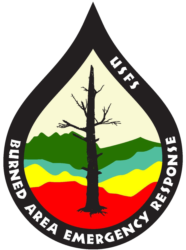BAER assessment teams are staffed by specially trained professionals that may include: hydrologists, soil scientists, engineers, biologists, botanists, archeologists, and others who evaluate the burned area and prescribe temporary emergency stabilization treatments to protect the land quickly and effectively. BAER assessments usually begin before a wildfire has been fully contained.
A BAER assessment team conducts field surveys and uses science-based models to rapidly evaluate and assess the burned area and prescribe emergency stabilization treatments. The team generates a “Soil Burn Severity” map by using satellite imagery which is then validated and adjusted by BAER team field surveys to assess watershed conditions and watershed response to the fire. The map identifies areas of soil burn severity by categories of low/unburned, moderate, and high. The higher the burn severity, the less soil will be able to absorb water when it rains. Without absorption, there will be increased run-off with the potential of flooding.
A BAER team presents these findings in an assessment report that identifies immediate and emergency actions needed to address post-fire risks to life and safety, property, cultural and critical natural resources. This includes maintaining native plant communities to prevent the invasion of noxious weeds. The BAER report describes watershed pre- and post-fire response information, areas of concern for life and property, and recommended short-term emergency stabilization treatments for Forest Service lands that burned.
In most cases, only a portion of the burned area is actually treated. Severely burned areas, steep slopes, and places where water run-off will be excessive and may impact important resources are focus areas and described in the BAER assessment report if they effect values-at-risk. Time is critical if the emergency stabilization treatments are to be effective.
There are a variety of emergency stabilization treatments that the BAER team can recommend for Forest Service land. Stabilization treatment examples are: mulching with agricultural straw or chipped wood and digging of below-grade pits to catch run-off and store soil sediment to keep roads and bridges from washing out during floods. A team also assesses if there is a need to modify drainage structures by installing debris traps, allowing drainage to flow if culverts become plugged, adding additional culverts, installing rolling dips, and constructing emergency spillways. BAER treatments cannot prevent all damage, especially debris torrents in areas that are prone to sliding and have lost critical root structure from plants.
